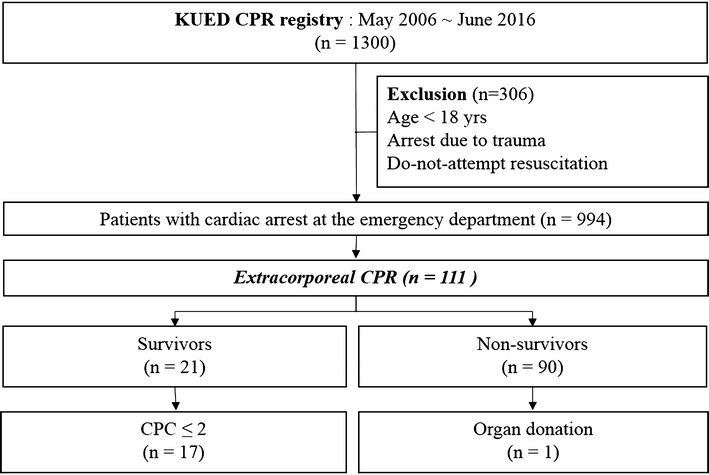Prognostic indicators of survival and survival prediction model following extracorporeal cardiopulmonary resuscitation in patients with sudden refractory cardiac arrest
- PMID: 28856660
- PMCID: PMC5577351
- DOI: 10.1186/s13613-017-0309-y
Prognostic indicators of survival and survival prediction model following extracorporeal cardiopulmonary resuscitation in patients with sudden refractory cardiac arrest
Abstract
Background: Extracorporeal cardiopulmonary resuscitation (ECPR) has been considered in selected candidates with potentially reversible causes during a limited period. Candidate selection and the identification of predictable conditions are important factors in determining outcomes during CPR in the emergency department (ED). The objective of this study was to determine the key indicators and develop a prediction model for survival to hospital discharge in patients with sudden cardiac arrest who received ECPR.
Methods: This retrospective analysis was based on a prospective cohort, which included data on CPR with ECPR-related variables. Patients with sudden cardiac arrest who received ECPR at the ED from May 2006 to June 2016 were included. The primary outcome was survival to discharge. Prognostic indicators and the prediction model were analyzed using logistic regression.
Results: Out of 111 ECPR patients, there were 18.9% survivors. Survivors showed younger age, shorter CPR duration (p < 0.05) and had tendencies of higher rate of initial shockable rhythm (p = 0.055) and higher rate of any ROSC event before ECPR (p = 0.066) than non-survivors. Eighty-one percent of survivors showed favorable neurologic outcome at discharge. In univariate analysis, the following factors were associated with survival: no preexisting comorbidities, initial serum hemoglobin level ≥14 g/dL, and mean arterial pressure ≥60 mmHg after ECPR. Based on multivariate logistic regression, predictors for survival in ECPR were as follows: age ≤56 years, no asystole as the initial arrest rhythm, CPR duration of ≤55 min, and any return of spontaneous circulation (ROSC) event before ECPR. The prediction scoring model for survival had a c-statistic of 0.875.
Conclusions: With careful consideration of differences in the inclusion criteria, the prognostic indicators and prediction scoring model for survival in our study may be helpful in the rapid decision-making process for ECPR implementation during CPR in the ED.
Keywords: Cardiac arrest; Cardiopulmonary resuscitation; Emergency department; Extracorporeal life support; Prediction; Survival.
Figures
Similar articles
-
Resistance to conventional cardiopulmonary resuscitation in witnessed out-of-hospital cardiac arrest patients with shockable initial cardiac rhythm.J Cardiol. 2016 Aug;68(2):161-7. doi: 10.1016/j.jjcc.2015.08.020. Epub 2015 Oct 2. J Cardiol. 2016. PMID: 26433911
-
Potential Candidates for Emergency Department Initiated Extracorporeal Cardiopulmonary Resuscitation (ECPR) in a Canadian Institution.Cureus. 2022 Sep 19;14(9):e29318. doi: 10.7759/cureus.29318. eCollection 2022 Sep. Cureus. 2022. PMID: 36277569 Free PMC article.
-
Refractory out-of-hospital cardiac arrest with ongoing cardiopulmonary resuscitation at hospital arrival - survival and neurological outcome without extracorporeal cardiopulmonary resuscitation.Crit Care. 2018 Sep 29;22(1):242. doi: 10.1186/s13054-018-2176-9. Crit Care. 2018. PMID: 30268147 Free PMC article.
-
Comparing extracorporeal cardiopulmonary resuscitation with conventional cardiopulmonary resuscitation: A meta-analysis.Resuscitation. 2016 Jun;103:106-116. doi: 10.1016/j.resuscitation.2016.01.019. Epub 2016 Feb 2. Resuscitation. 2016. PMID: 26851058 Review.
-
A systematic literature review and meta-analysis of the effectiveness of extracorporeal-CPR versus conventional-CPR for adult patients in cardiac arrest.J Intensive Care Soc. 2019 Nov;20(4):347-357. doi: 10.1177/1751143719832162. Epub 2019 Mar 4. J Intensive Care Soc. 2019. PMID: 31695740 Free PMC article. Review.
Cited by
-
Experience of extracorporeal cardiopulmonary resuscitation in a refractory cardiac arrest patient at the emergency department.Clin Cardiol. 2019 Apr;42(4):459-466. doi: 10.1002/clc.23169. Epub 2019 Mar 18. Clin Cardiol. 2019. PMID: 30820972 Free PMC article.
-
What factors are effective on the CPR duration of patients under extracorporeal cardiopulmonary resuscitation: a single-center retrospective study.Int J Emerg Med. 2024 Apr 17;17(1):56. doi: 10.1186/s12245-024-00608-2. Int J Emerg Med. 2024. PMID: 38632515 Free PMC article.
-
Predictors of survival and neurologic outcome for adults with extracorporeal cardiopulmonary resuscitation: A systemic review and meta-analysis.Medicine (Baltimore). 2018 Nov;97(48):e13257. doi: 10.1097/MD.0000000000013257. Medicine (Baltimore). 2018. PMID: 30508912 Free PMC article.
-
Extracorporeal cardiopulmonary resuscitation for adults with shock-refractory cardiac arrest.J Am Coll Emerg Physicians Open. 2021 Jan 18;2(1):e12361. doi: 10.1002/emp2.12361. eCollection 2021 Feb. J Am Coll Emerg Physicians Open. 2021. PMID: 33506232 Free PMC article. Review.
-
Surgical results in acute type A aortic dissection with preoperative cardiopulmonary resuscitation: Survival and neurological outcome.PLoS One. 2020 Aug 24;15(8):e0237989. doi: 10.1371/journal.pone.0237989. eCollection 2020. PLoS One. 2020. PMID: 32834010 Free PMC article.
References
-
- Callaway CW, Soar J, Aibiki M, Bottiger BW, Brooks SC, Deakin CD, et al. Part 4: advanced life support: 2015 international consensus on cardiopulmonary resuscitation and emergency cardiovascular care science with treatment recommendations. Circulation. 2015;132(16 Suppl 1):S84–S145. doi: 10.1161/CIR.0000000000000273. - DOI - PubMed
-
- Brooks SC, Anderson ML, Bruder E, Daya MR, Gaffney A, Otto CW, et al. Part 6: alternative techniques and ancillary devices for cardiopulmonary resuscitation: 2015 American heart association guidelines update for cardiopulmonary resuscitation and emergency cardiovascular care. Circulation. 2015;132(18 Suppl 2):S436–S443. doi: 10.1161/CIR.0000000000000260. - DOI - PubMed
-
- Brown KL, Dalton HJ. Extracorporeal Cardiopulmonary Resuscitation:ECPR. In: Annich GM, editor. ECMO Extracorporeal Cardiopulmonary Support in Critical Care. 4th ed. Ann Arbor, Michigan, USA: Extracorporeal Life Support orarnization; 2012. pp. 331–7.
LinkOut - more resources
Full Text Sources
Other Literature Sources



